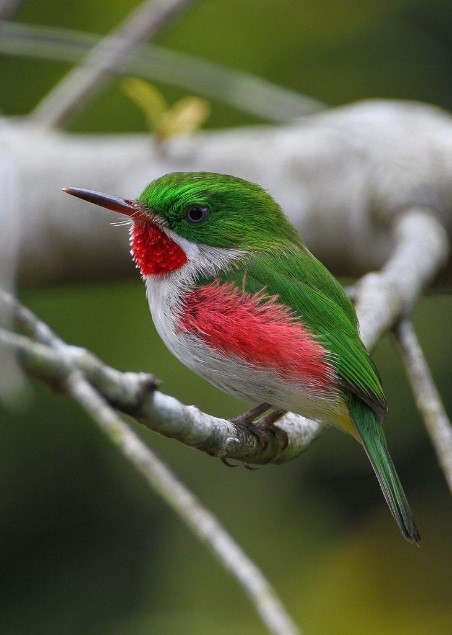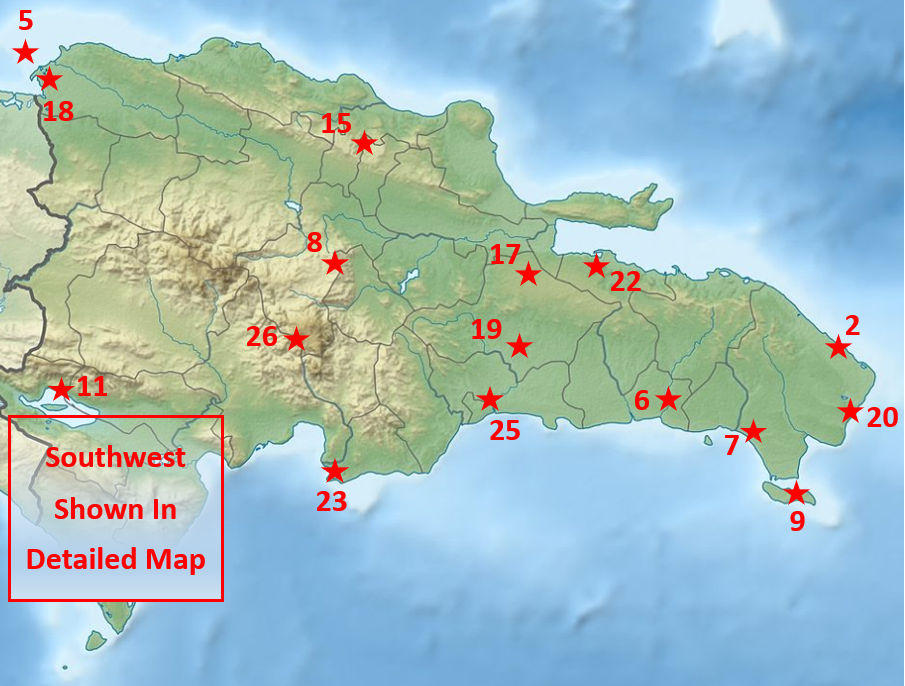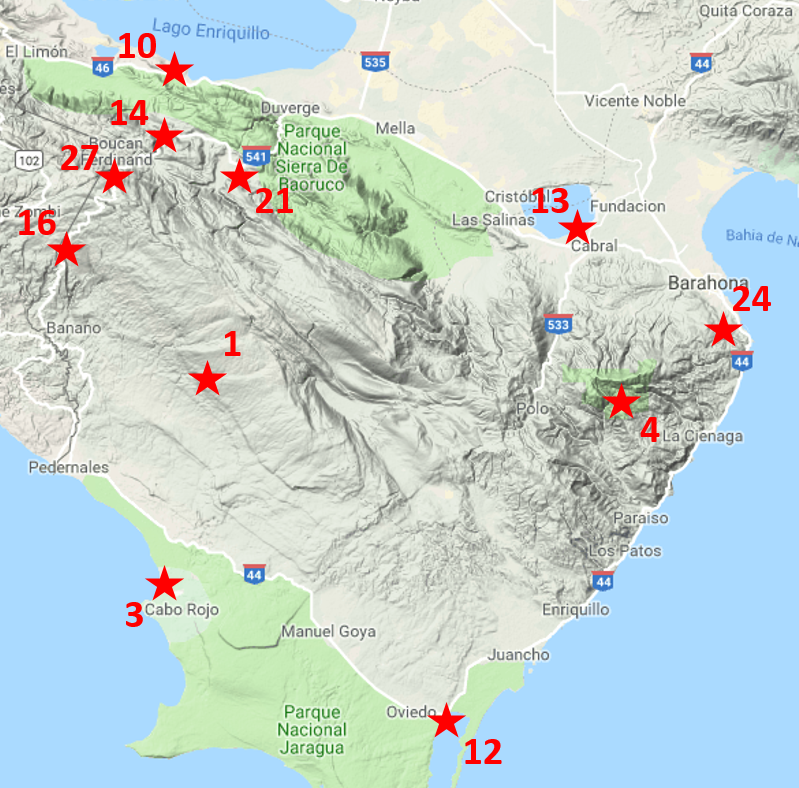The Avitourist’s Guide to the Dominican Republic

The endemic Narrow-billed Tody. © Dax M. Román E.
Hispaniola is the central land mass of the West Indies. It has the highest mountains, the largest lakes, and the longest rivers in the region. So it is not surprising that it also has the most endemic birds, with 36 (or so) species and three families that are confined to the island and its satellites. For more detailed information on its birds, see Birds of Hispaniola.
Most of Hispaniola’s avian diversity can be sampled in either Haiti or the Dominican Republic, but Haiti’s history of chaos and catastrophe discourages most foreign tourists from visiting. Instead they go to the D.R., which has surged in popularity as a destination in the 2000s, particularly the seaside resort enclaves of Punta Cana and Puerto Plata. As a result, it is well served by airlines, with many direct flights daily to and from the U.S., and it has well-developed tourist infrastructure.
Unlike most other West Indian destinations, the D.R.’s economy does not revolve around tourism, though it is a significant component. Away from the major resort areas, Dominicans generally do not regard foreigners with envy or suspicion, and opportunistic crime against visitors is rare. Most Dominicans are more likely to offer assistance than to request it. On the whole, the population is friendly, welcoming, generous, and happy—in the objective sense that it scores high on the global “happiness index.”

The endemic Ashy-faced Owl. © Pedro Genaro Rodríguez
It is easy to get to the D.R., but logistics within the country can be challenging. Drive times between sites are long and the quality of the roads is inconsistent and unpredictable. Heavy rains often cause extreme erosion that leaves mountain roads impassable for weeks or months, so a plan that includes a visit to remote mountains should include one or two extra days to solve any problems that arise, and it is wise to arrive equipped with Plans B and C. Such trips are best regarded as adventures rather than routine excursions.
The map below shows many of the D.R.’s favored birdwatching locations, with links to detailed accounts of certain locales. Read beyond that for general orientation on possible game plans for touring the D.R. indpendently.
For more detailed logistical guidance and a directory of ecotour operators, see Travel to the Dominican Republic.
Dominican Republic – Orientation Map


1 – Alcoa Road
2 – Bávaro
3 – Cabo Rojo
4 – Cachote
5 – Cayos Siete Hermanos
6 – Cumayasa
7 – Del Este National Park
8 – Ébano Verde Scientific Reserve
9 – Isla Saona
10 – Lago Enriquillo, South Shore
11 – Lago Enriquillo National Park
12 – Laguna de Oviedo
13 – Laguna de Rincón
14 – La Placa
15 – Loma Quita Espuela
16 – Los Arroyos
17 – Los Limones
18 – Monte Cristi National Park
19 – Monte Plata
20 – Punta Cana Ecological Reserve
21 – Rabo de Gato Trail
22 – Sabana de la Mar
23 – Salinas de Baní
24 – Santa Elena Road
25 – National Botanical Garden
26 – Valle Nuevo National Park
27 – Zapotén
The Southwest
Hispaniolan endemics are not evenly distributed around the D.R. They are disproportionately concentrated in its wild southwestern corner, on the slopes of the Sierra de Bahoruco, where all but two of the island’s 36 (or so) endemic bird species can be found in four or five days of dedicated effort—leaving Ridgway’s Hawk and Gray-crowned Palm-Tanager to be sought elsewhere. Most organized tours focus on four sites:
The Rabo de Gato Trail (Site # 21), adjacent to the town of Puerto Escondido, can produce most of Hispaniola’s endemic birds in a compact, easily accessible area, and is especially noted for White-fronted Quail-Dove and Least Pauraque.
Zapotén Road leads from Puerto Escondido through the dry forest zone at La Placa (Site # 14) up to mixed cloud and pine forest at Zapotén (Site # 27), a rough, exhausting ride that provides the best opportunity to find Bay-breasted Cuckoo, Hispaniolan Kingbird, La Selle Thrush, White-winged Warbler, and Western Chat-Tanager.
On the southern slope of the Sierra de Bahoruco, Alcoa Road (Site # 1) is an anomalous paved road up to the pine forest, a relic of a bygone era of bauxite mining, that is still easily driven in a passenger car, and the most reliable site for Stygian Owl, Hispaniolan Nightjar, Hispaniolan Palm Crow, Golden Swallow, and Hispaniolan Crossbill.
On the eastern slope of the Sierra de Bahoruco in the cloud forest at the end of a famously rough road, Cachote (Site # 4) is the most accessible site for Eastern Chat-Tanager with healthy populations of many other montane forest species, notably Rufous-throated Solitaire.
In addition to these heavily visited sites, the southwestern D.R. has many more areas worthy of exploration. The following is by no means an exhaustive list:
Along the southern shore of Lago Enriquillo (Site # 10) a few km west of Duverge is a consistent site for both endemic crows, White-necked and Hispaniolan Palm. Accessed from its northern shore, Lago Enriquillo National Park (Site #11) also has both crows as well as American Flamingo, American Crocodile, and Rhinoceros Iguana.
Beside the Haitian border, above Pedernales, Los Arroyos (Site #16) is the southern extension of Zapotén—though less information is available, it appears to support all the same species.
At the southern extension of Alcoa Road, Cabo Rojo (Site #3) is a popular beach with adjacent mangroves and lagoons that support many waterbirds, including “Caribbean Clapper Rail,” and often “Atlantic White-tailed Tropicbirds” just offshore.
Midway between Barahona and Pedernales, Laguna de Oviedo (Site # 12) has a large resident flock of American Flamingo, among other waterbirds.
Just south of Barahona, Santa Elena Road (Site #24) is known for several nightbirds, including Ashy-faced Owl, Least Pauraque, and “Caribbean Potoo.”
West of Barahona, Laguna de Rincón (Site #13) is the largest freshwater lake in the West Indies, with populations of Masked Duck and Yellow-breasted Crake.
Most of the Sierra de Bahoruco is roadless and appears likely to remain an undeveloped reservoir of biological diversity for the foreseeable future. South of the southern highway, most of the Barahona Peninsula is protected as Jaragua National Park.
Santo Domingo and the Interior
For visitors whose travel plans will take them through the capital Santo Domingo, the National Botanical Garden (Site #25) is a good place to become familiar with several of the common endemics, and to see Hispaniolan Parakeet, which can be difficult to find elsewhere.
For those who plan to remain in Santo Domingo for a few days, there are several other interesting sites within a comfortable driving distance:
Less than an hour’s drive north of the capital, the palm plantations near Monte Plata (Site #19) support populations of Double-striped Thick-knee and Ashy-faced Owl.
An hour beyond Monte Plata, the village of Los Limones (Site #17) is the nearest site for Ridgway’s Hawk, and also a consistent spot for Antillean Piculet.
At two hours from the capital, Ébano Verde Scientific Reserve (Site #8) is the nearest site that supports most of Hispaniola’s highland endemics, including Eastern Chat-Tanager (though it is difficult to find here).
Alternatively, it is three hours’ drive to Valle Nuevo National Park (Site #26) which has most of the same species, but is more reliable for Golden Swallow.
An hour and a half west of the capital, Salinas de Baní (Site #23) is among the best sites on the island for shorebirds.
Punta Cana and the East
At the eastern tip of Hispaniola, Punta Cana has become one of the most popular tourist destinations in the Caribbean, and its busy airport makes it a convenient entry point into the D.R. It is far removed from any mountains so not an ideal base for chasing endemics, but nonetheless offers interesting opportunities to find some uncommon species.
In the main resort area, Bávaro (Site #2) is a good site for most of the widespread endemics, as well as Hispaniolan Parrot, Hispaniolan Parakeet, and Hispaniolan Oriole.
A few miles south of town, Punta Cana Ecological Reserve (Site #20) is the release site for the reintroduction of Ridgway’s Hawk.
An hour’s drive west of Punta Cana brings you to the western entrance to Del Este National Park (Site #7), which has populations of Flat-billed Vireo and White-necked Crow. A short distance offshore, Isla Saona (Site #9) is part of the park, popular as a tourist excursion, with limited bird diversity, but known for its White-necked Crows and a nearby Magnificent Frigatebird colony.
A short drive west of the popular resorts at La Romana, Cumayasa (Site #6) is a scenic area where most of the widespread endemics, as well as Double-striped Thick-knee and Hispaniolan Kingbird, can be found.
Two hours northwest of Punta Cana, Sabana de la Mar (Site #22) is the main entry point to Los Haitises National Park, home to the native population of Ridgway’s Hawk, Ashy-faced Owl, White-necked Crow, Hispaniolan Oriole, and several commoner endemics.